Short & Long English Vowels
The English vowels are A, E, I, O, & U. (Sometimes Y is a vowel, pronounced as if it were I. Sometimes W substitutes for U, especially in the digraph 'ow.') Each vowel can be pronounced in several ways.This page explains when each sound is commonly used.
(Most of this information applies to English in general, though the exact sounds differ slightly. For vowel digraphs & R-controlled vowels, I'm describing general American English, That's what the video demonstrates. British & Australian forms can be quite different, so the IPA symbols may also vary.)
Use these links to jump to a section lower down on the page:
- Long vowels & their rules
- A video with more details on short and long vowel pronunciations
- Examples comparing long and short vowels (and showing the effect of the silent 'e')
- Other Vowel sounds (including those affected by a following 'R')
- More information on vowel sounds & spellings.
Short Vowels
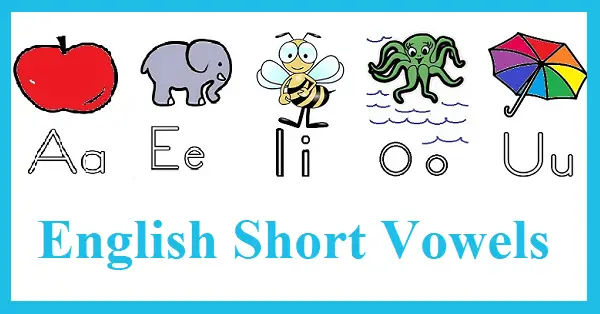
The most common sound for each vowel is its “short” sound:
- ă, pronounced /æ/ as in apple, pan, or mat,
- ĕ, pronounced /ɛ/ as in elephant, pen, or met,
- ĭ, pronounced /ɪ/ as in insect, pin, or mitt,
- ŏ, pronounced /ɑ/ as in octopus, ostrich, upon, or motto,
- and ŭ, pronounced /ʌ/ as in umbrella, pun, or mutt.
(The International Phonetic Alphabet symbol for each sound is inside the backslashes://. You do not need to understand the IPA symbols; just look for an example word you know how to pronounce. For those who want more, this Wikipedia article gives a fairly simple demonstration of the IPA as used in English. It links to more detailed information.)
We call these vowel sounds "short," but they are not all spoken more quickly than the "long" sounds. However, it's important to learn to pronounce these five sounds, because each is the most common sound for its letter. The main rules for when to use them and when to use "long" vowel sounds apply to all five of them.
When syllables end in a vowel and then consonant (as in the examples above), the vowel is usually short. If the vowel is followed by more than one consonant, it is almost always short.
This becomes important as a way to keep the same vowel sound when adding -ed to put a verb into the past tense. We often double an ending consonant to keep a short vowel short. For example, the past tense of 'stop' is 'stopped.' Otherwise the silent 'e' rule below (which also applies when followed by 'ed') would give it a long 'o' sound like soap or hope. See the Simple Past Tense explanation of spelling changes.
Long Vowels
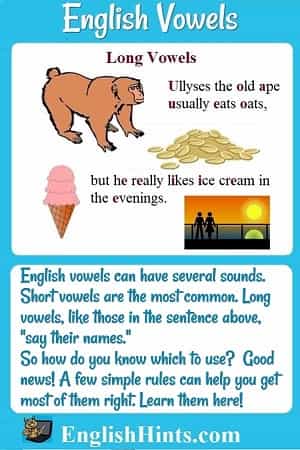
The alphabet sounds (when the vowel “says its name”) are called “long vowels.”
We call them ‘long’ because we hold most of them slightly longer than the short sounds.
However, they are completely different sounds-- not a longer version of the same sound.
- Long A (ā), pronounced /eɪ/ as in late or mate,
- Long E (ē), pronounced /iː/ as in eat or meat (or meet or mete-- all pronounced the same),
- Long I (ī), pronounced /aɪ/ as in mite or might,
- Long O (ō), pronounced /oʊ/ as in oats, mote or moat, and
- Long U (ū), pronounced /juː/ as in mute or /uː/ as in blue.
Rules for When Vowels Will (Probably) Be Long
The short sound of each vowel letter is more common. When in doubt, use the short sound, unless one of the following rules applies. The silent E rule is especially useful. There are a few exceptions (given below), but it applies to thousands of words. You cansee examples of how it and these other rule
Silent ‘E’
Rule: When a
vowel and single consonant are followed by an ‘e’ (in the same syllable), the ‘e’ is almost always silent,
but it causes the preceding vowel to be long. (Examples: ate, plane, Pete, bite,
nine, rope, note, cube, flute.)
There are just a few exceptions, most involving a 've' or an 'ne': above, dove (the bird), give, have, live (the verb), love, move, prove, solve, etc. A few others: are, come, done, gone, none, and one, as well as the 'I' in office.
Those words are common, but many more words ending -ve, -one, & -ice are long: cove, dive, dove (the past tense), drive, drove, five, gave, grove, hive, knives, live (the adjective), pave, revive, save, stove, strive, survive, thrive; alone, bone, cone, phone, stone, tone; & advice, dice, ice, nice, price, rice, etc.
Other Long Vowels: A vowel at the end of a syllable is almost always long. Examples: I, we, he, she, go, try, potato and tomato. (Some English speakers use a short ‘a’ in the 2nd syllable, while others use a long ‘a,’ but both ‘o’s are long for everyone.)
-Igh and -ight are usually long I (and silent GH): bright, fight, high, light, might, night, right, sigh, sight, tight.
Often the first letter of the vowel combinations, especially ‘ai’, ‘ay’, ‘ea’ (sometimes-- see Digraphs, below), ‘ee’, & ‘oa,’ will be long & the second will be silent. (An old rhyme for children says “when 2 vowels go walking, the first does the talking.”) So ’plain’ sounds exactly like ‘plane,' ‘meat’ and ‘meet’ like ‘mete,’ etc.
However, there are many exceptions. (See the link to English Vowel Digraphs, at the bottom of this page, for the most common ones.)
Listen to Some Words with Short & Long Vowels
Here's a demonstration of words mentioned above-- & more.
Common Examples: Short and Long Vowels
These contrasts demonstrate the rules (in each column, first short, then long):
|
|
|
A: short back snack fad mad Sam can plan tap at E: short bed Ben men ten bet set I: short lick hid slid dim fin lit sit O: short rob hop mop cot not U: short cub tub hug cut |
A: long bake snake fade made/maid same cane plain/plane tape ate E: long bead bean mean teen beat/beet seat I: long like hide slide dime fine light/lite sight/site O: long robe hope mope coat note U: long cube tube huge cute |
Other English Vowel Sounds
Besides the long and short sounds, there are other sounds English vowels can make.
Many vowels in unaccented syllables have a neutral or “schwa” /ə/ sound. Examples: the ‘a’ in above or approve, the ‘e’ in accident, camera or mathematics, the ‘i’ in family or officer, the ‘o’ in freedom or purpose, or the ‘u’ in industry or succeed.
In the U.S., this is very close to the short 'U' sound. I can't hear the difference, except that the vowels are often harder to hear at all in unaccented syllables.
Vowel Digraphs
Two vowels written together (digraphs) may be a diphthong, combining the two sounds, (like the oi/oy in boy, point, or ointment).
They may instead be pronounced in various other ways, depending on the combination.
Some (like ai or ay, ea, ee, or oa), use the long (or in a few cases the short) sounds above.
Others (au/aw, oo, and ou or ow) may use these sounds or others. See Vowel Digraphs for a full explanation.
R-Controlled Vowels
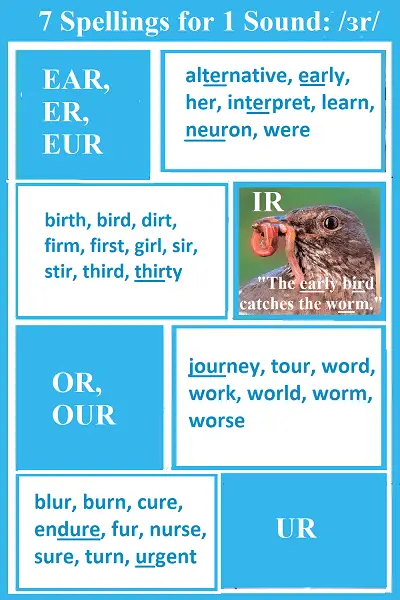
if a vowel comes before R, it changes in quality, and is neither long nor short. (ER, IR, and UR are often -- though not always--the same sound.)
Examples with phonetic symbols:
- /ɑr/ -- arm, car, charge, dark, farm, start
- /ɛər/-- air, aware, bare/bear, hair, spare, tear (pull apart paper or fabric), there, very, where
- /ɪər/-- beer, ear, hear/here, near, tear (from crying)
- /ɜr/ -- curt, discern, first, fern, herd, hurt, earth, mirth, service, slur, whirl, worry, worth
- /ər/ -- baker, better, bigger, doctor, letter, smaller, summer
- /ɔr/ -- course, for (or four), important, more, north, or, source, war (or wore), your (or you're)
Exceptions, Dialects, & Help
Quite a few common words spelled with ‘O’ are pronounced with a short ‘U’ sound: of, love, money, other, some, son. (That means some and sum are homophones: they sound the same. So are son and sun.) See the course below for more examples and practice.
Different English dialects pronounce certain vowels differently than the general rules given above. For example, in California and much of the U.S., the ‘a’ in ‘father’ or ‘want’ sounds like the ‘au’ in ‘audio’ or the short ‘o’ in ‘pot’ or ‘hot.’ In many other places that’s not true.
Ate, the past tense of eat, is pronounced with a long 'a' (/eɪ/) in North America, but more often as 'et' (with a short 'e') in British English.
Another example: the /ɜr/ in bird, burn, earth, etc. is generally pronounced /ər/ in the U.S. and some other areas.
Don't worry about these differences. English speakers can almost always understand people speaking other dialects of English. If you live in any area for a while, you'll be able to adjust to them-- and most are not very different.
For the exact pronunciation of any English vowels, consult a good dictionary. Most list the sound symbols they use on one of the front pages. Good online dictionaries like the Oxford Advanced Learner's Dictionary will let you listen to the pronunciation. (This dictionary gives both British and American pronunciations of each word.)
Updated Course on English Vowel Sounds & Spellings
Are you interested in learning more about the relationship between English vowel sounds and spellings?
There have been so many positive comments on this page that I designed a short course about it. I recently improved it and also added a section on words of more than one-syllable, especially some important academic words. Knowing which syllable to stress can make these words much simpler to pronounce (and to spell).
The course can help you recognize more of the words you know when you read them. It will also help you spell better and pronounce new words. Learn more and sign up here.
If there are certain things you especially want to learn about vowel sounds or spelling, you can also leave a comment or question in the box below.
If you would like, you can download a pdf summary on short & long English vowels (as requested in the comments). (It includes color images to help you recognize each sound, as described in the course information above. The course has more details. It also has information & practice on R-controlled vowels and other vowel sounds: au, oi, oo, ou and more.)
Because English has adopted words (and often some of their sounds), from so many other languages, none of these rules is always true.
However, these English vowel rules will help you guess at the pronunciation of words you read. For that reason, they may also help you guess their meaning, if you have heard them but not read them before. They should also help make English spelling a little easier.
English spellings and pronunciations are complicated-- almost crazy! It helps to have a good sense of humor and not worry too much about them. Learn them when you have a chance. If you need to know a pronunciation, check a dictionary! That's the one really safe rule.
* This color vowel chart has more information & links on remembering vowel sounds by using colors.
You Might Also Like:
ESL Phonics lists the basic sounds of each letter, with examples.
Learn the different sounds consonant digraphs can make.
They all can help you pronounce what you read-- or spell what you can say.
Home > How to Improve English Pronunciation > Short & Long English Vowels
Didn't find what you
needed? Explain what you want in the search box below.
(For example, cognates, past tense practice, or 'get along with.') Click to see the related pages on EnglishHints.
| site search by freefind | advanced |
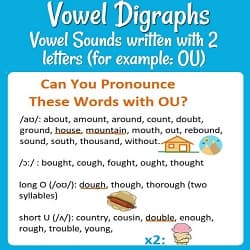
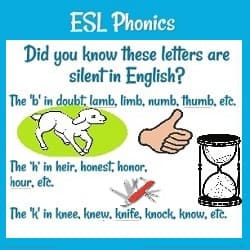
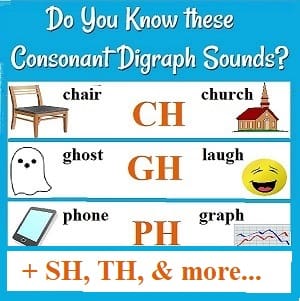



New! Comments
What do you think about what you just read? Leave me a comment in the box below.